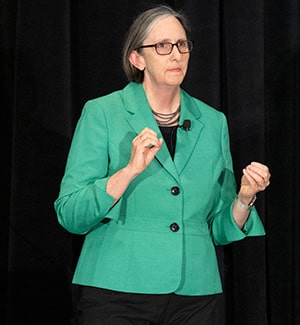By Members of the American Association for Cancer Research Associate Member Council Kristin Altwegg, PhD, Heather Beasley, PhD, Katie M. Campbell, PhD, and past member, Bianca Islam, MD, PhD, MSc
During the National Cancer Institute (NCI) Director’s Address and Fireside Chat at the American Association for Cancer Research (AACR) Annual Meeting 2024, Kimryn Rathmell, MD, PhD, inspired many in the audience—including members of the AACR Associate Member Council (AMC)—with her vision and objectives for cancer research and patient care.
Wanting to learn more about her career trajectory and lessons for the next generation of cancer researchers, past and present AACR AMC members had the opportunity to sit down with Rathmell to address questions about resiliency in a scientific career, mentorship, women in leadership roles, communicating science, the age of artificial intelligence, and more.
“And then sometimes things in life come along and really rock your world”
Kristin Altwegg: I had the opportunity to take the Becoming a Resilient Scientist series through the National Institutes of Health (NIH) Office of Intramural Training and Education, and the AACR AMC recently shared an article on “Resilience as an Early-Career Researcher.” How has resilience played a role in the steps that you have taken and the decisions that you have made over the course of your career?
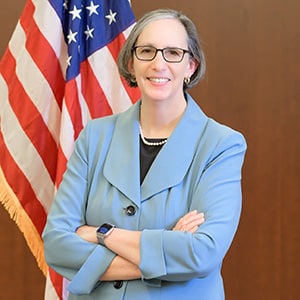
Kimryn Rathmell: I would like to read your article. I think that might be enlightening for me as well. I’m not sure that this career is particularly different from others in terms of how much resiliency helps, but it certainly does help. One example I remember as an undergraduate was of learning how to stand up for what it was that I wanted to do with my career. This was not a career path that was something everybody thought I should do. Being willing to say, “No, I think I can,” actually gives you a career—that’s step one.
I look at experiences that I had later in graduate school. Actually, I was a medical student first, and then had to decide that I was on this path and going to pause, earn a PhD, and create the career of a physician-scientist. As you all know, this comes with some built-in challenges around the fact that science is hard. That’s why it takes a long time to learn how to do it. Experiments fail, hypotheses turn out to be incorrect, which is why we test them. And in science we thrive on rigor, which means that we invite criticism.
That’s not always fun, but it helps us learn how to be as rigorous as we can be. We learn how to handle the rejection of papers and grants and other things that we try to get approved. In the middle of all of that training period, life goes on. I had my first child while in graduate school, and I was learning to decide “is this doable” and “how am I going to navigate the expense of an additional person in my house,” as well as being a parent and a student and advancing a scientific career. Each of those things helps you measure how sturdy you are. And then sometimes difficulties in life come along and really rock your world and things pause. My father died by suicide when I was a fellow and I had to navigate my family through a very difficult experience and make decisions about what was possible.
That probably influenced me a lot as an early-career faculty member because I was coming out of that and was very much “head down, focus on my science, blinders on,” and maybe that was good. I didn’t take on a lot of extra things early on. That was the easiest thing for me to do. But I want to add that I think resiliency is more than a personal core strength, it also comes from the people around you, your network and community are a great source of resiliency, especially when your own inner reserve might be weaker. I’m looking forward to reading your paper because I think we all need to understand where we gain our resiliency.
“We are surrounded by superstars and sometimes forget that we are also superstars”
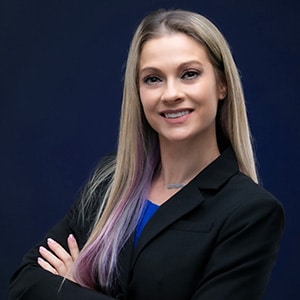
Kristin Altwegg: The Becoming a Resilient Scientist series has a lecture on impostor fears. In both the early and later stages of your career—and in becoming the director of NCI—have you ever encountered impostor fears and, if so, how did you get through them? If you have students or mentees in similar situations, how do you support them?
Kimryn Rathmell: Yeah, I think it’s pretty natural. We work in a very high-level arena and we are surrounded by superstars and sometimes forget that we are also superstars. So, it’s easy to look around at all of these people, as if this is an elite sport that we’ve all chosen to do. And you’re in there—I like basketball analogies—passing the ball and maybe you’re not scoring points yet, but that doesn’t mean you’re not playing right along with the superstars. I have felt impostor syndrome in that space at almost every step of the way.
One of my most notable experiences that I can point to was when I was elected as the president of the American Society for Clinical Investigation. Okay, it’s a big deal. And I went to my first meeting as the incoming president. I had just been elected and there was definitely a sense of impostor syndrome going into that. So much so that for a black-tie event, I had planned to wear something that somehow I thought no one would really notice me. Like black, and simple, and out of the way because I just wanted to get through it.
And then, someone told me something about how big of a deal it was and asked, did I really feel it? And so, at the last minute, I packed this big, gold dress that I’d never worn before. And it had an effect on me—I felt like I had just had cataract surgery. Like I suddenly could see them and me in a different way because my impostor syndrome was definitely holding me back. And I thought to myself I’m going to own this thing. It was transformational, and it was a lot about that dress.
“Mentorship is more than teaching about science, it’s more than telling people to think bigger than where they are”
Heather Beasley: Switching a little bit from resiliency more so to mentorship, we want to talk a little bit about some of your earliest mentors that really have shaped you. Like yourself, I had my first baby in grad school, and mentorship is extremely important. How did these mentors shape your decision to be a physician-scientist, and were there mentors that helped you transition to your leadership role as the NCI director?
Kimryn Rathmell: A lot of people had small and large roles in helping me find the way. In terms of becoming a physician-scientist, I have to point to my PhD advisor, Gilbert Chu, MD, PhD, at Stanford. And it wasn’t subtle. I was a med student working in his lab and he said, “You should get a PhD. You should be a physician-scientist. This is the only way. You love asking and answering questions. You love the connections.” But it wasn’t that easy for me. I mean, it took years of him saying that over and over again for me to say, “Okay, I think I can actually do that!” So, it wasn’t just once, and he was fairly persistent about it.
I mentioned that I had my first child in grad school. When I told him that, he was thrilled. He said, “That is great!” And this is back in the day when there was no maternity leave for grad students. We just worked it out and I had an appropriate amount of time in which I just disappeared from the lab because he was supportive. And that’s just one example. He was supportive of me and the other people in the lab throughout. So, mentorship is more than teaching about science, it’s more than telling people to think bigger than where they are. And it goes all the way to helping them develop as people through the years that you’re working with them. So, I have to give him props for me being here at all.
And then more recently, the easiest person to point to is Ned Sharpless, MD, who was an NCI director before me, who also came from UNC-Chapel Hill. I had spent 12 years there. And Ned was starting his lab about a year before I started my lab. So, Ned has been a peer mentor for me for a long time. He was in the lab down the hall. He knew all this stuff about what you do with graduate students, where you get things done in core facilities, and how you write letters for people. I’ve had all those conversations with Ned. Ned was a very easy person to turn to and say, is this a good idea? What did you like? What didn’t you like? And then I actually met with him about every week for my first two months as NCI director. This place had lots of acronyms and structures that were unfamiliar. And you walk into a brand-new place and it’s all really different. Having a guide was essential.
“Women in leadership roles … it’s about speaking up and feeling confident in our own skin … and being recognized on a purely merit-based system”
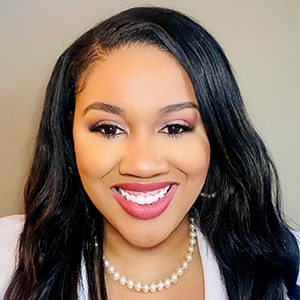
Heather Beasley: As women leaders supporting one another, I want to talk about some of the challenges that you faced and that you might face, to give the AACR Associate Members something to think about with respect to navigating these decisions that we all have to make, both professionally and personally.
Kimryn Rathmell: It’s important that people look out for each other. In a long-ago era there was a sense that women necessarily didn’t do that for each other. I’ve never had that experience, but I know that’s experienced by many. I think in the current era, there are enough women out there who know what we all need in terms of respect and recognition and to be a part of the team—that there is a lot of camaraderie out there. There’s a real sense of people working to lift each other up, which the field needs, and I think is a newer way things are working.
It’s also recognizing that seeing women in these kinds of leadership roles is not just about addressing childcare and maternity leave. It is about a lot more than that. It’s about overcoming imposter syndrome, it’s about recognizing when that’s happening and helping people move through that and recognize their own strengths and capabilities. It’s about overcoming some of the challenges that we have from our upbringing. It’s about speaking up and feeling confident in our own skin and recognizing where cultural norms are getting in the way of people doing the work and being recognized in a purely merit-based system.
We all want to be recognized for the work that we’re doing and for what we’re contributing to the fight against cancer. And that gets in the way when a lot of us are the first woman. I really don’t like being referred to as the first woman. Now I’m the second woman in this job, so that’s a lot easier. Being recognized as the first woman kind of sounds like maybe you only got it because you’re a woman. I’d rather win an award or have a prize or be recognized because what I did moved the needle and it was viewed as important!
“Talking to advocates … I find that to be one of the most rewarding things that I do now”
Bianca Islam: Just over the past decade, I think we’ve seen communication reaching far nationally and internationally through the use of social media. As a group, we think of communication in four roles: press/media, patients and patient advocates, policymakers, and underserved communities. Just from watching you, we know that you have experience in communicating with all these groups at different points of your career. Of these four groups, which group would you say has been the most challenging to talk to, and how have you worked to improve that?
Kimryn Rathmell: I think all of those are important—and all of those are difficult. It’s good that you identify these categories of communication because it helps when it comes to improving things. I would put scientific communication as maybe the easiest one. Maybe that’s because we get the most training on that and because we learn a lot about that, we do a lot of that, we’re used to the modes of communication. I find all the others to be somewhat harder. The media is hard because your quotes may go out in print but can be misunderstood without any editing or context.
It’s a different feeling of visibility and vulnerability when talking in that venue, because it feels somehow more, maybe it’s because it’s reaching a different audience. I certainly hope that the papers I write that go into journals are read by lots of people in the scientific community. But if you say something on a podcast, I don’t really know who those people in the audience are. And you don’t know how your words will resonate. That’s a different stress level.
It’s important to spend time thinking about and learning how to say something depending on who you are talking to. I thought that I might mention talking to advocates in this conversation. I find that to be one of the most rewarding things that I do now, but I thought that was very challenging early on, partly because I’m more of a basic scientist. I could lean into my physician experience and talk patient and clinical matters and that resonates.
But if I really want to talk, if I really want to connect in a way that’s even more meaningful with advocacy groups, I need to convince them that the science that I’m doing is important and help them understand what it is and how it all fits in. Those conversations can be harder because the language is not always there. But pushing through those difficult conversations to the place where you can actually connect can be even more powerful. Those conversations are super important and it’s worth having the hard part.
“Having advocates who are in the peer review space makes you write a grant in a little bit of a different way”
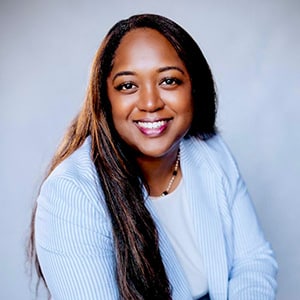
Bianca Islam: That makes a lot of sense, and it actually leads into some follow-up questions. As scientists, our bread and butter is to get grants and funding, and a lot of foundations and organizations are including patients and patient advocates in the decision-making process for awarding grants. I’m aware that the Veterans Affairs system, and some foundation grants include patient advocates, but I’m not sure about the NIH. On a broader scale, how are we going to help early-career scientists navigate this path? How do we introduce someone who may not be a physician, how do they get access to advocates, and what kind of training could be provided by mentors to help facilitate that?
Kimryn Rathmell: I think it’s just creating those opportunities and being willing to have some discomfort in conducting some of those conversations. Having advocates who are in the peer review space makes you write a grant in a little bit of a different way—and that’s good. I tell this story often, but we had a patient advocate come to our laboratory retreat and it really was transformative. It changed the whole tenor of the conversations of the students and postdocs once we had someone from outside our world, but who was very interested and engaged, wanting to understand what they were doing.
“We’re all scientists, and we’re all learning, and we’re all here to make a difference”
Katie Campbell: One of the things that I love was that you focused on asking yourself “is this what I want to be doing,” especially as an undergraduate. As we interact with more trainees, their assumption is that they’re supposed to go into academia, but academia is not the traditional route anymore. It might be traditional in that it’s a long historic route for a PhD scientist, but it’s not the customary route anymore. Can you talk a little bit more about the diversification in the workforce, not just in the people sense, but also the training. How do we support trainees across these areas?
Kimryn Rathmell: First, we’re all scientists, and we’re all learning, and we’re all here to make a difference. That’s why people go into these fields. So, the workforce has changed. It used to be that the dominant path where people would move through the system was to transition into academic jobs. I don’t think there are actually fewer academic jobs than before, but I also don’t think that as an industry, academia has grown as much as the private sector. And so, the balance is now quite different.
I think that has changed some of the ways that we approach training, that it’s good for people to be open to what they want to do and helping them figure that out. You know, it’s not always obvious. I say that I was sure I was going to be a physician-scientist. I’m not sure that I knew. It evolved with time and with some experimentation and testing what I liked and what I didn’t. I look for my folks in the lab to have that same opportunity. It’s wonderful that there are a variety of ways that people can try teaching, for example.
Most universities have—I know Vanderbilt has one—a program where you can spend some time working at a primarily teaching college. That is one route. I’ve had a couple of students love doing that. Others love the drug development part of it, or some other aspect that really lends itself well to the industry sector. Others have gone to government and others have gone to academic labs. We should appreciate the wide array of opportunities that are out there. And just be honest about what path people are ready for, what path they’re really setting themselves up to follow.
“But in terms of informatics … it’s really moving into an essential skill that people have to have some knowledge of to be able to do the work that we do”

Katie Campbell: And one final question and kind of building upon this is—we’re comfortable teaching what we know, right? And while you go to a lab for training in a particular thing, AI and ChatGPT have transformed the way that we think about how we can do science and really accelerated that. How do you support trainees who want to do something different than you (it’s not different from how our parents raised us in a certain way)? As we prepare to be mentors in this field, how do we better prepare to be mentors and trainees as we transition into the age of AI?
Kimryn Rathmell: I think your analogy is great about parenting—it’s about looking at where people’s talents lie. We’re also in an era where collaboration is the norm. And so, we can help to find those kinds of opportunities for people. For example, I still can’t really do computational biology even today, but in the earlier days of my laboratory, we needed to move into that space. This is when we had gene arrays, before RNA-seq was cool, but even that was hard.
We had a partnership where a student went and stayed with another lab for two weeks, learned those skills, and then we collaborated with them for years. That student is actually now the director of clinical bioinformatics at Memorial Sloan Kettering. So, the informatics stuck for her. But in terms of informatics, use of AI, and the quantitative aspects of cancer research, it’s really becoming an essential skill that people must have some knowledge of to be able to do the work that we do.
The post Early-career Cancer Researchers Interview NCI Director Kimryn Rathmell appeared first on American Association for Cancer Research (AACR).



